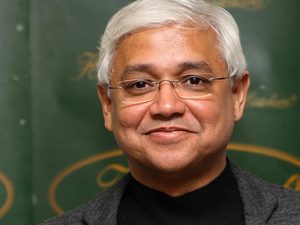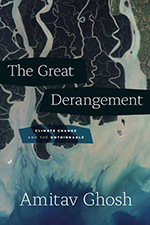Plants are failing to absorb our carbon emissions, decades before expected, says Dr. James Curran from Scotland. Then celebrated Indian author Amitav Ghosh on new book “The Great Derangement: Climate Change and the Unthinkable”.
Welcome to Radio Ecoshock. You can listen right now with the player below:
Our first guest is Professor James Curran from Scotland. Formerly the head of the Scottish Environmental Protection Agency, Curran has published new science that shakes our planning for climate change to the core. The plants it seems are soaking up less and less of the carbon dioxide we pump into the sky. Peak carbon is not later in this century, as predicted, but behind us. It’s stunning news that makes climate action so much more urgent than you’ve been told.
Then you’ll hear from one of India’s best known authors, in both fiction and non-fiction. Amitav Ghosh has just released his newest book, “The Great Derangement: Climate Change and the Unthinkable”. In a wide-ranging interview, we look at climate change from the other side of the world.
Download or listen to this Radio Ecoshock show in CD Quality (56 MB) or Lo-Fi (14 MB)
*************************************************************
AN UPDATE ON MY URGENT APPEAL FOR RADIO ECOSHOCK SUPPORT
Thanks to a wave of donations and subscriptions from listeners all over the world (really!) – the Radio Ecoshock bank account has recovered to about half the level needed to keep it going into next February. I’m so grateful to those who gave (you will get an thank-you email soon).
Meanwhile, I’m still looking for more donations and subscriptions this week, so I can just go back to producing important radio for you. To find out more, please check out this page.
http://www.ecoshock.org/2016/10/urgent-appeal-from-alex-smith.html
**********************************************************************************
A LITTLE SHOT OF CLIMATE NEWS
In the news, climate scientists are already at work analysing the role of climate change in deadly Hurricane Matthew, the strongest storm to hit the Carribean and America’s East coast in a decade. The seas there were 3 and more degrees hotter than normal. The hotter atmosphere was overloaded with extra water vapor. We’ll await the post-mortem. In this program, Amitav Ghosh talks about the modern migration of humans to the sea coasts, just at the time when that becomes the most dangerous place to be.
Un-reported except in the Siberian Times, scientists have found still more methane leaking from frozen deposits on the shallow sea beds of the East Russian Arctic. Professor Igor Semiletov, of Tomsk Polytechnic University returned on a Russian research ship, finding “significantly” more methane escaping than measure on earlier ventures from 2011 to 2014. The methane amounts are not yet at panic level, but it’s a danger sign from one of the most likely sources of a rapid climate shift. Thanks to our guest scientist Paul Beckwith for that tip.
And check out this Arctic alarm from the normally staid World Meteorological Association.
In a new report, “The Truth About Climate Change”, top level scientists says the 2 degree climate danger mark has moved forward in time, from the end of this century to 2050. As Ian Johnson writes in the Independent,
“it means the majority of people alive today will experience what it is like to live on a dangerously overheated planet.” I’ll try to find out more on that for you.
Let’s get to our interviews.
PEAK CARBON: PROFESSOR JAMES CURRAN
Most of the land on Earth is in the Northern Hemisphere. What if all the plants there started to capture less and less carbon dioxide from the atmosphere? Surely that couldn’t happen.
Our guest was the chief executive of the Scottish Environment Protection Agency or SEPA. Now James Curran is co-author of a new study published in the journal “Weather” on September 1, 2016. The title is: “An estimate of the climate change significance of the decline in the Northern Hemisphere’s uptake of carbon dioxide in biomass.” It’s not good news.
Find the full paper here.

Here’s the big worry. The IPCC (Intergovernmental Panel on Climate Change) calculated that around 2075, the plant world would start to take up less and less carbon. Maybe we’d see the start of that process by 2035? Meanwhile, the idea of plants as a sink which will thrive with more CO2 and warmth is built into every carbon budget ever released. The catch is: actual measurements of CO2 at Maunu Loa show that tipping point is already in the rear view mirror. It happened in 2006, Curran tells us, and he explains how we know that.
That’s a huge change in our understanding of the role of plants under climate change. As Naomi Klein might say “this changes everything”.
WHY ARE PLANTS SOAKING UP LESS CO2?
Although various mechanisms causing a reduction in carbon dioxide uptake by plants appear in our broadcast interview, I asked Professor Curran to outline why. This is what he wrote (an addition to our audio interview):
It is a key issue, so would certainly merit your emphasis if it didn’t, as appears, come across quite strongly enough.
The decline in the ability of the biosphere to absorb and lock up, or sequester, carbon may be due to a number of reasons:
Rapidly increasing temperatures, to which plants cannot accommodate themselves quickly enough (after all trees can’t uproot and move polewards to keep cool), may mean they’re just not growing as well, as fast or as healthily as they used to. Remember that this is on average – across all plant species across the whole of the N. hemisphere.
Increasing spells of drought in certain parts of the world (the USA has suffered lengthy droughts, as has the Middle East and the Amazon rainforest, for example) could be seriously damaging both natural vegetation and human crops in their ability to thrive and absorb carbon from the atmosphere.
Extreme wind events, predicted under climate change, could be resulting in significant forest damage through wind-throw and imposing another negative impact.
Wildfires, on an extensive scale including Indonesia, Russia, Alaska, and mainland USA, could be destroying vegetative cover and, as you rightly say, also burning the soils which store large amounts of carbon. This process turns naturally sequestering ecosystems into huge emitters of carbon dioxide.
Drought, as I mentioned, could also be turning peat deposits into carbon emitters rather than carbon absorbers due to drying out, cracking, losing structural cohesion, collapse and either direct oxidation into CO2 or erosion, in later heavy rainfall events, and washing out into rivers – which are certainly exhibiting rising dissolved organic carbon levels in many parts of the world. There seem to be many Scottish examples of this, sadly.
On the other extreme, flooding can kill off vegetation and crops by root saturation. Or it can wash out soils, and wash out vegetation itself.
On a smaller scale, but also on a global scale, hugely important is the way soil biodiversity functions. We probably don’t know enough about how temperature and water content and variability/extremes affects soil ecosystems and their ability to function effectively and store carbon and support a healthy above-ground vegetative ecosystem.
You’re absolutely right that a programme is doubtless merited on this subject, possibly using peatlands as an exemplar of soil fragility under climate change. Soil is definitely the Cinderella environmental compartment.
Finally, very recently, a published paper indicated that melting permafrost, again in the N Hemisphere predominantly, might be beginning to emit CO2 during the summer months (equivalent clearly to a reduction in sequestration) . The paper suggests this is not yet significant but must be monitored as it is likely to worsen in years to come. Yet another positive feedback mechanism that is very worrying….”
That’s from an email to Alex Smith, from our guest Professor James Curran at University of Reading.
Download or listen to this 24 minute Radio Ecoshock interview with James Curran in CD Quality or Lo-Fi.
If you’d like to read more, here’s a good article on this new science.
AMITAV GHOSH – THE GREAT DERANGEMENT
Heating up a small planet affects everyone everywhere, no matter who releases the greenhouse gases into the atmosphere. I’m always looking for voices outside the bubble of the Western-style consumer culture. Our next guest was born in the Indian mega-city of Kolkata, studied at the Delhi School of Economics, and got his PhD at Oxford. Currently, when he is settled anywhere, Amitav Ghosh lives in New York.

But Ghosh is most widely known for his writing. His best selling novels make him one of the souls of India. His mastery of fiction and non-fiction make him a bridge to English readers as well. Here is a powerful introduction to Amitav Ghosh, recorded at the launch of his new book “The Great Derangement” – in his birthplace of Kolkata.
Download or listen to this 29 minute Radio Ecoshock interview with Amitav Ghosh in CD Quality or Lo-Fi
And find out more at Amitav’s web site here.
Here is the eloquent introduction to Amitav Ghosh, given as the book launch of “The Great Derangement” in Kolkata, India on August 1st, 2016 – as recorded on You tube.
“Amitav Ghosh is the author of such acclaimed fiction as “The Circle of Reason” which was of course his debut novel, “The Shadow Lines”, “The Kolkata Chromosomes”, “The Glass Palace”, “The Hungry Tide” and the Ibis Trilogy: “Sea of Poppies”, “River of Smoke”, and “Flood of Fire”.
His notable non-fiction writings are “In an Antique Land”, “Dancing in Cambodia”, “Countdown”, and “The Imam and the Indian”. In “The Great Derangement: Climate Change and the Unthinkable”, which is Amitav’s first major work of non-fiction since “In an Antique Land”, he examines our inability – at the level of literature, history and politics – to grasp the scale and violence of climate change.
The climate crisis asks us to imagine other forms of human existence. It’s a task to which fiction, Amitav argues, is the best-suited of all cultural forms. His book serves as a great writer’s summons to confront the most urgent task of our times.”

On You tube, you can watch the whole thought-provoking conversation between Amitav Ghosh and film-maker Srijit Mukherji. Find it here.
RISING SEAS AND STRONGER STORMS: THE CASE OF MUMBAI
I was in Mumbai back in 1979, when it was still called by it’s colonial name of Bombay. Since then, the population has more than doubled to almost 21 million in Metro Mumbai today. But it’s not just the challenge of population. At the same time, scientists have concluded that stronger storms will arise in the Arabian Sea, as climate change progresses. Add that storm surge to rising sea levels, and you have a super-risk for Mumbai.
Mumbai is built on reclaimed land on a long thin peninsula completely exposed to the sea. New York and Mumbai were founded in the 1660’s, by the British, who liked islands accessible to the sea, but defensible.
Like Wall Street in New York, Mumbai is the finance capital of India, and a world player. That was closed down temporarily in 2005 when huge floods struck the city. But all this is just a prelude to the next super-storms.
Meanwhile there are two nuclear reactors, one on either side of Mumbai. As we saw in Fukushima Japan, large waves followed by the power grid going down, can cause nuclear reactors to melt-down.
The catastrophe that we are speaking of is on a scale that is almost unimaginable. Eleven million people would have to be evacuated from southern Mumbai. In Sandy and Katrina we find most people don’t leave. There is no where to go. People stay behind, and many die, plus property damage. Anyone who lives there should consider how they will get out in event of a major storm.
THE GREAT FLOODS OF CHENNAI
Then we talk about Chennai, right on the banks of the river and close to the sea on the East coast of India. In November and early December of 2015, stunning floods buried Chennai and it’s surrounding region in water. Over 500 people died. Industry was paralysed for more than a month (and is still struggling to recover).
Despite all that, Ghosh tells us a gigantic luxury apartment block is being built near the water in Chennai – with a 7 story basement! Local planners and builders still don’t get it!
Kolkata, formerly known as Calcutta, is so risky, it is left out of reports on Asean cities at risk. There are still some wetlands around Kolkata, but if those are developed as well, Ghosh says his birth city is “doomed”. As in New Orleans, most of Kolcotta is below sea level. It’s a disaster waiting to happen.
We also talk about the low lands of the Northeast state of Bengal, close to Bangladesh, and just as likely to succumb to rising seas, displacing millions – to where?
WHY THE HUMAN MIGRATION TO THE COAST?
An awe-inspiring part of Ghosh’s thoughts on climate involves the still-larger pattern of populations all over the world moving toward the seas, at the exact time in history when that is very dangerous. Why did that migration away from inland agricultural lands happen? I’m told that 50% of the American population now live within 100 miles of the Atlantic or Pacific coast.
FAILURE TO ADAPT
Whether it’s Chennai or Mumbai, Miami Beach or New Jersey, after each flood people and their politicians promise to rebuild everything in exactly the same dangerous places. It’s madness. How is it possible that we can go on living the fossil-powered dream, even when we know everything we have is endangered by disruption of the climate?
Scientists cannot explain this flaw in human nature: our failure to adapt. Even psychologists cannot solve it. What can artists and authors do?
We talk about why literature has really turned away from climate change. Even journalists who were flooded out in Mumbai in 2005 didn’t write about it. Do we lack the words to describe climate-driven mega-events?
If you would like to hear more of Amitav Ghosh on climate change, I also recommend this interview on the Indian TV show “Standard Time” (published on You tube August 13, 1016).
That’s it for Radio Ecoshock this week. Be sure to check out my web site at ecoshock.org for all our past programs. You can download programs with some of the world’s top scientists, authors and activists – all for free thanks to support from our listeners. Please, take the opportunity to get educated on our future, and ways to save it.
I’m Alex Smith. Thank you for listening, and thank you for caring about our world.
Great guests Alex, especially Mr. Ghosh. Thank you so much for turning me on to this wonderful and gifted person.
With regards to the report in the Siberian Times a week and a half ago about steadily increasing rates of sub-seafloor methane from the Laptev Sea (and surely the other shallow seas off Siberia), how unsurprising that the mainstream media hasn’t even touched this life-altering information. It may not be ‘panic level’ but to go from 100+ methane seeps in the Laptev study area in 2011 (many of them 1 km across) to 500 in 2014 to however many now, surely is something pernicious. How is this in our hands at this point? Dr Guy McPherson has been waving an often lonely flag on this subect for some time now. Now, the esteemed Dr. Peter Wadhams and Dr. Igor Semiletov, in very recent weeks, are loudly ringing the hydrate bell. Putting aside newly discovered rainforest ‘zombie’ emissions and just regular old co2 time lag issues.
I look forward to the results of the expedition, culminating in that conference in Tomsk at the end of November
Pingback: Your Friday Morning Collapse | Loki's Revenge
Professor James Curran and you, Alex are perfectly correct about conventional agriculture in destroying the ability of the soil and hence the ability for plants (and crops) growing in it to take up carbon dioxide – increasing temperatures has the same effects. What is needed, is what I and others, including the late Bill Mollison, have advocated have advocated for some time, we need to go back to a perennial-based sustainable (no tilling) agricultural system combined with a modern replication of a savanna-like eco system that can have moving livestock (cattle, chickens, pigs, etc. replacing bison, buffalo, wildebeest, elephants, etc.) in constantly moving electro fenced, carefully managed (optimum carbon-sequestering grass growing conditions – minimalizing any consequential methane releases).
Alex, you need to have someone on who can better explain all this like Daren Doherty, Mark Shepard, Joel Salatin or someone from the Savory Institute.
Keep up your good work,
John
Pingback: Life Under A Damaged Sky – RADIO ECOSHOCK – Deadend, Left